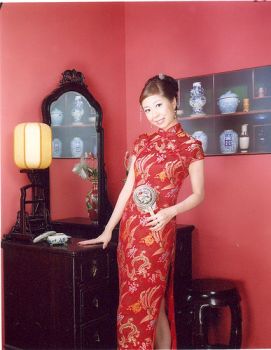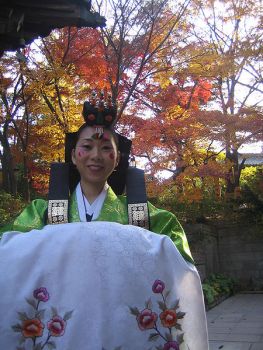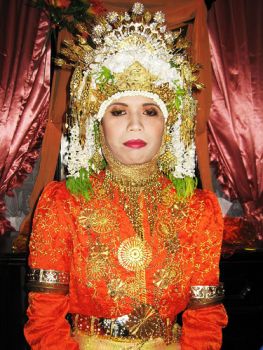TITLE
A wedding dress or wedding gown is a type of garment worn by the bride during wedding ceremony. Its colour, style and importance differ according to religion and culture in general. Throughout the centuries a wedding dress has always been an indicator of bride's social status.
In the western world the wedding dress is traditionally white. The first documented wedding where the bride wore the white wedding dress was the one of Philipa of England (1394-1430). This wedding ceremony was performed in 1406. White wedding dresses became popular many centuries after that. Queen Victoria and Albert of Saxe-Coburg got married in 1840. She wore white. The wedding photo was published in the papers. Soon after that many more brides started wearing white wedding dress. Before mentioned royal wedding women wore wedding dresses of different colour. In northern Europe black colour was the most common.
 Chinese Qi Pao dress
Chinese Qi Pao dress
Western style wedding dress is quite popular in other cultures. Despite this trend many traditional wedding dresses are still used. In several Asian countries, like for example China, India and Vietnam, they are red. Red is the colour of good luck and success. In the north of China brides traditionally wear a frock called “Qi Pao”. In the south of the country there is a two-piece dress called “Qun Gua”. This dress is also known as “Kwa” or “Cheongsam”. The dress has golden phoenix and dragon decorations.
In India wedding sari has golden embroidery. Kerala is the Indian state located in the southwest of the country. Wedding sari there is white or of cream colour. It also has golden embroidery. Wedding saris are traditionally made of silk fabric.
Ao dai is the Vietnamese traditional clothes which is also used as the wedding dress. Here the dress is worn over loose silk pants. The dress vary in its length. It can be just below the knee or even to the ground. The Vietnamese bride wears an outer robe (“the ao choang”) over the ao dai. She also wears a hat. The non la and khanh vanh hats are the most popular.
Brides on the Indonesian island of Java wear the kebaya. It is a traditional combination of blouse and dress. It is usually worn with sarong or batik. Baro't saya is the national costume of the Philippines. Local brides wear it at their wedding.
 Korean bride
Korean bride
Some Korean brides still choose to wear the traditional “hanbok” costume at their wedding. A bride wears the “wonsam” (silk coat) or “hwarot” (silk garment, usually red) over the hanbok. “Mongolian bride wears light coloured “del”. This long dress is made of cotton and silk with patterns.
Aceh is the Indonesian region located in the northern part of the island of Sumatra. The wedding dress worn by brides in Aceh is called “ineun mayak”.
 Ineun mayak – Aceh, Indonesia
Ineun mayak – Aceh, Indonesia
Native American Hopi nation have an interesting tradition concerning clothes worn by the bride. It is woven by the groom. Other men in the settlement can participate too. Traditional wedding garments include a belt, two white robes, white robe with red stripes at its top and bottom, white buckskin leg coverings and moccasins and a string used for tying hair. There is also a reed mat used to wrap all the garments. Everything mentioned has one additional purpose. Apart for weddings it is also essential for the person's journey through the underworld.
The woman belonging to the Delaware nation would traditionally get married wearing a skirt of deerskin and a band of wampum beads around her forehead. In the winter she would also wear deerskin leg coverings, moccasins and a special robe made of turkey feathers. Bride's face would be painted with white, red and yellow clay.
The Yurok, the Modoc and the Klamath are the tribes from the Northern California. The colours present on their wedding dress have symbolic meaning – white for east, yellow (orange) for west, blue for south and black for north. Turquoise and silver jewelry and a silver concho belt were not worn only for decorative purpose. It was believed that they have the power to protect the person from hunger, poverty and bad luck.
Mexican bride traditionally wears mantilla veil. She can wear either of two type of dresses – slim dress with bolero jacket or the Flamenco-type of dress. There is also a tradition of bride carrying colourful fan.